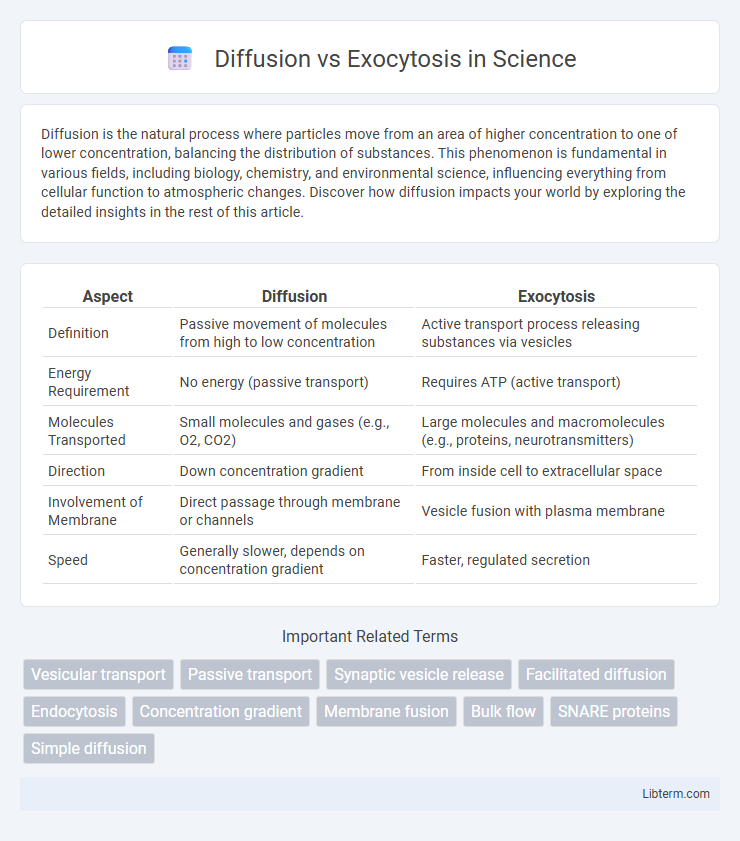Diffusion is the natural process where particles move from an area of higher concentration to one of lower concentration, balancing the distribution of substances. This phenomenon is fundamental in various fields, including biology, chemistry, and environmental science, influencing everything from cellular function to atmospheric changes. Discover how diffusion impacts your world by exploring the detailed insights in the rest of this article.
Table of Comparison
| Aspect | Diffusion | Exocytosis |
|---|---|---|
| Definition | Passive movement of molecules from high to low concentration | Active transport process releasing substances via vesicles |
| Energy Requirement | No energy (passive transport) | Requires ATP (active transport) |
| Molecules Transported | Small molecules and gases (e.g., O2, CO2) | Large molecules and macromolecules (e.g., proteins, neurotransmitters) |
| Direction | Down concentration gradient | From inside cell to extracellular space |
| Involvement of Membrane | Direct passage through membrane or channels | Vesicle fusion with plasma membrane |
| Speed | Generally slower, depends on concentration gradient | Faster, regulated secretion |
Introduction: Understanding Cellular Transport Mechanisms
Diffusion and exocytosis are fundamental cellular transport mechanisms essential for maintaining homeostasis and facilitating intracellular communication. Diffusion involves the passive movement of molecules from areas of higher concentration to lower concentration across the cell membrane, driven by concentration gradients without energy expenditure. Exocytosis, an active transport process, enables cells to expel large molecules such as proteins and neurotransmitters by vesicle fusion with the plasma membrane, requiring energy in the form of ATP.
Defining Diffusion: The Basics
Diffusion is the passive movement of molecules from an area of higher concentration to one of lower concentration, driven by the concentration gradient without energy input. It enables substances like oxygen, carbon dioxide, and small lipid-soluble molecules to cross cell membranes efficiently. This contrasts with exocytosis, an active transport process requiring energy to move large molecules or vesicles out of the cell.
Exocytosis Explained: A Cellular Export Process
Exocytosis is a vital cellular export process where vesicles containing molecules fuse with the plasma membrane, releasing their contents into the extracellular space. This mechanism enables the transport of proteins, neurotransmitters, and waste products, maintaining cellular function and communication. Unlike diffusion, which passively moves molecules across membranes, exocytosis is an active, energy-dependent process critical for regulated secretion and cell signaling.
Comparing Passive and Active Transport
Diffusion is a passive transport mechanism where molecules move from an area of higher concentration to lower concentration without the use of cellular energy, allowing substances like oxygen and carbon dioxide to cross cell membranes efficiently. Exocytosis is an active transport process requiring energy, typically ATP, to transport large molecules such as proteins and neurotransmitters out of the cell by vesicle fusion with the plasma membrane. The key difference lies in diffusion's reliance on concentration gradients and exocytosis's dependence on energy-driven vesicular transport, highlighting their distinct roles in cellular material exchange.
Key Differences Between Diffusion and Exocytosis
Diffusion is a passive transport mechanism where molecules move from an area of higher concentration to lower concentration without energy expenditure, while exocytosis is an active transport process involving vesicles that fuse with the plasma membrane to expel materials outside the cell using ATP. Diffusion primarily handles the movement of small, nonpolar molecules across the cell membrane, whereas exocytosis manages the secretion of large molecules such as proteins and polysaccharides. The rate of diffusion depends on concentration gradients and membrane permeability, whereas exocytosis is regulated by cellular signals and vesicle trafficking mechanisms.
Biological Importance of Diffusion
Diffusion plays a crucial role in biological systems by enabling the passive movement of molecules such as oxygen, carbon dioxide, and nutrients across cell membranes without energy expenditure, facilitating essential cellular functions. This process maintains homeostasis by regulating the internal environment of cells, ensuring proper concentration gradients are preserved for efficient metabolic activity. Unlike exocytosis, which requires energy to transport large molecules or waste out of the cell, diffusion supports continuous and spontaneous molecular exchange fundamental to cell survival.
The Role of Exocytosis in Cellular Function
Exocytosis plays a critical role in cellular function by facilitating the transport and release of large molecules, such as proteins and neurotransmitters, that cannot pass through the lipid bilayer via simple diffusion. Unlike diffusion, which relies on concentration gradients for passive movement of small molecules, exocytosis involves active transport mechanisms that require energy to fuse vesicles with the plasma membrane, ensuring precise and regulated secretion. This process is essential for maintaining cell communication, membrane repair, and the removal of cellular waste, highlighting its importance in overall cellular homeostasis.
Examples of Diffusion in Living Organisms
Diffusion in living organisms includes oxygen moving from alveoli into blood capillaries and carbon dioxide diffusing out of cells into surrounding fluids. Nutrient molecules like glucose diffuse from the intestinal lumen into epithelial cells for absorption. Water diffusion through cell membranes via osmosis maintains cellular homeostasis and supports metabolic functions.
Real-World Examples of Exocytosis
Exocytosis plays a crucial role in neurotransmitter release at synaptic junctions, enabling rapid neuron-to-neuron communication essential for brain function. In pancreatic beta cells, exocytosis facilitates insulin secretion, regulating blood glucose levels and maintaining metabolic homeostasis. Immune cells utilize exocytosis to secrete antibodies and signaling molecules, enhancing the body's defense mechanisms against pathogens.
Summary: Choosing Diffusion or Exocytosis in Cellular Processes
Diffusion efficiently facilitates passive transport of small, nonpolar molecules across cell membranes without energy expenditure, making it ideal for rapid and continuous molecular exchange. Exocytosis actively transports larger molecules, such as proteins and neurotransmitters, by vesicle fusion with the plasma membrane, requiring ATP for targeted secretion and membrane remodeling. Selecting diffusion or exocytosis depends on molecular size, polarity, and cellular energy availability, aligning with specific physiological demands.
Diffusion Infographic

 libterm.com
libterm.com